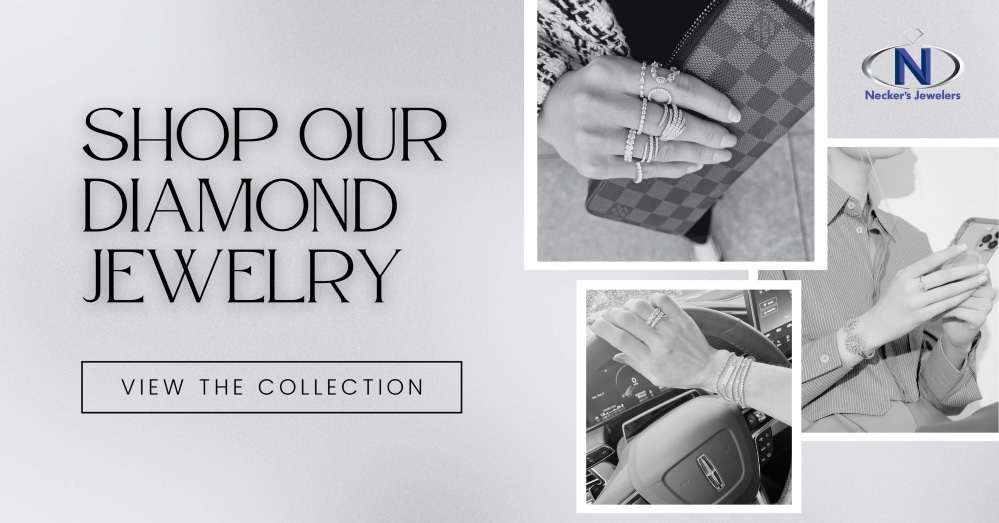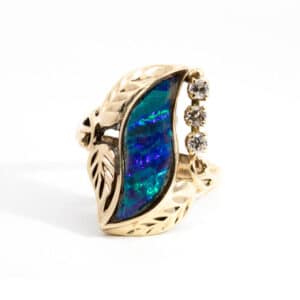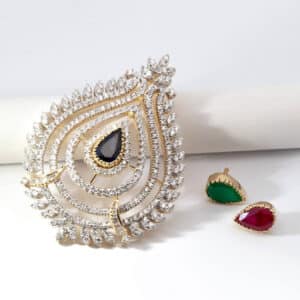Home / News & Events / Diamond Fluorescence: Why Is My Diamond Glowing?

Have you ever visited a haunted house or gotten a manicure at a nail salon and noticed your diamond ring was glowing? Don’t worry! This glow is called fluorescence, and it occurs naturally in some diamonds.
Fluorescence is light that’s produced by an object when that object absorbs ultraviolet light. When this glow is observed in diamonds after they’re exposed to UV light it’s called diamond fluorescence.
Why Diamonds Fluoresce
Diamonds can fluoresce in UV light because of their crystal structure, and impurities that develop within the diamond’s structure while it’s forming. This phenomenon isn’t rare, either. According to GIA, fluorescence is observed in approximately 25 to 35% of all natural diamonds. However, while some diamonds have the ability to fluoresce, the strength of their fluorescence varies.
What Fluorescing Diamonds Look Like
Most diamonds that fluoresce will glow blue when exposed to UV light. However, some diamonds will also appear yellow, green, magenta, and red when fluorescing.
Diamonds can also have different levels of fluorescence. There are five classifications, or grades, that are used to describe a diamond’s level of fluorescence: none, faint, medium, strong, and very strong. These fluorescing levels can alter a diamond’s appearance in a variety of ways.
How Fluorescence Affects a Diamond’s Appearance
Depending on the diamond, diamonds that fluoresce may look different than the exact same diamond that doesn’t fluoresce.
Here are a couple examples:
If a diamond is slightly hazy, fluorescence can amplify this cloudiness. This is usually more of an issue with strong or very strong fluorescing diamonds, and diamonds that are colorless or nearly colorless.
If a diamond has a lower color grade near the yellow end of the diamond color spectrum, fluorescence may make this diamond appear less yellow and closer to colorless than it actually is. This is a good thing, because the closer a diamond is to being colorless typically indicates an increase in the diamond’s value.
What to Consider When Deciding Whether to Purchase a Fluorescing Diamond
When you’re thinking about purchasing a diamond with or without fluorescence, it’s all about preference. If you prefer the look of a fluorescent diamond, that’s the right diamond for you. And if you don’t—that’s perfectly fine too! Considering the level of fluorescence in a diamond and how it can affect the way the gemstone looks is important so you can identify which diamonds you’ll love for years to come.
When buying diamonds, we recommend looking at your stone in a variety of lightings, so you can see if the diamond’s fluorescence, or lack thereof, presents a noticeable difference in the diamond’s appearance. This way you know before purchasing the diamond what it will look like in different types of lighting. An easy way to do this is to look at the diamond in both indoor lighting and sunlight.
Want to learn more about diamonds? We’ve written a blog post that’s perfect for you: Diamonds: 10 Facts About April’s Birthstone | Necker’s Jewelers.

-
 ESTATE OPAL & DIAMOND RING$469.00
ESTATE OPAL & DIAMOND RING$469.00 -
 ESTATE ONYX AND DIAMOND RING$219.00
ESTATE ONYX AND DIAMOND RING$219.00 -
 ESTATE DIAMOND NECKLACE$699.00
ESTATE DIAMOND NECKLACE$699.00 -
 ESTATE SOLITAIRE DIAMOND NECKLACE$349.00
ESTATE SOLITAIRE DIAMOND NECKLACE$349.00 -
 ESTATE DIAMOND DANGLE EARRINGS$399.00
ESTATE DIAMOND DANGLE EARRINGS$399.00 -
 ESTATE DIAMOND RING$149.00
ESTATE DIAMOND RING$149.00 -
 ESTATE DIAMOND FASHION RING$799.00
ESTATE DIAMOND FASHION RING$799.00 -
 ESTATE DIAMOND & BLUE STONE RING$799.00
ESTATE DIAMOND & BLUE STONE RING$799.00 -
 ESTATE 3CT DIAMOND FASHION PENDANT WITH INTERCHANGEABLE GEMSTONE CENTER$2,999.00
ESTATE 3CT DIAMOND FASHION PENDANT WITH INTERCHANGEABLE GEMSTONE CENTER$2,999.00


